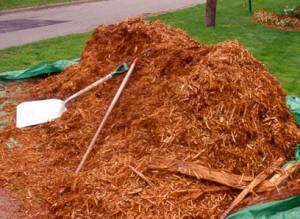|
 |
|
 |
This term applies to a wide array of materials that may be
applied to the surface of the soil in beds and borders. They
all serve basically the same roles in our gardens and may
originate from either organic or inorganic sources.
A. The Role of Mulch - A nice layer of 2 or 3 inches of
mulching material can do wonders for your beds and borders.
The major impacts of mulch in the landscape include:
-
Moisture Conservation - A layer of mulch will cover the ground
and intercept the rays of the sun. This will decrease the
amount of evaporation from the soil resulting in water
conservation and the need for fewer applications of
irrigation. Also, organic mulches will soak up some of the
water which will also discourage loss through evaporation.
-
 Aesthetics
- Decorative mulches will add to the
aesthetic impact of a landscape. Using the same mulch
throughout the landscape, will serve to "tie it together".
This will make the total landscape appear as a cohesive unit
rather than a random collection of beds and borders. Aesthetics
- Decorative mulches will add to the
aesthetic impact of a landscape. Using the same mulch
throughout the landscape, will serve to "tie it together".
This will make the total landscape appear as a cohesive unit
rather than a random collection of beds and borders.
-
Weed Control - Weeds, especially annuals that come up
from seed, will be deterred from emerging through this extra
layer on top of the soil. Perennial plant weeds may still
make it through but they will need to use more energy to
make it to the surface. As a result of this struggle they
may not be so numerous or vigorous as they would be on bare
soil.
-
Cool the Soil - By shading the soil, the mulch will
lower the soil temperature of the root zone of the plants
below. This is a general benefit for most plants. For some,
like
clematis, who like to have "their heads (stems and
flowers) in the sun but their feet (roots) in the shade" a
layer of mulch may lead to a healthier, more vigorous plant.
B. Types of Landscape Mulch
-
Organic Mulch - Probably the most common type of
mulching material falls into the organic category. These
mulches are made up of parts of dead plants. This would
include shredded bark, wood chips, recycled wood pallets,
cocoa bean hulls and many other such products. Some of these
are artificially dyed in order to maintain their color
throughout the summer.

-
Inorganic Mulch - Stones, rocks and pebbles of various
sizes, shapes and colors would fall into this category.
These materials may absorb heat and actually raise the
temperature of the soil below. Be careful to be sure that a
stone mulch fits in with the design intent for your
landscape.
-
Synthetic Mulch - There are several synthetic fabrics
that are routinely used in landscape beds and borders. In
the olden days, it was common to use a layer of black
plastic as mulch. The plastic was usually covered with
another layer of rocks or organic material. These
installations looked good the day the job was done but the
plastic would eventually become brittle and begin to shred
apart. It would often give the area a very messy appearance.
Although it does block the growth of most weeds, plastic
does not allow moisture to penetrate to the roots of the
desired plants.
Today, there are several woven fabric materials that allow
moisture and oxygen to penetrate while blocking the growth
of weeds from below. The down side is that soil will often
accumulate on top of the fabric over the years. Eventually,
weeds may be able to take root and grow.
|
|
Post-Planting Care of
Landscape Plants |
|
|
|
|
 |
|
Note: We
have provided some general information and
observations on this topic aimed at the home
gardener. Before you take
any serious action in your landscape, check
with your state's land grant university's
Cooperative
Extension
Service for the most current,
appropriate, localized recommendations. |
|
|



